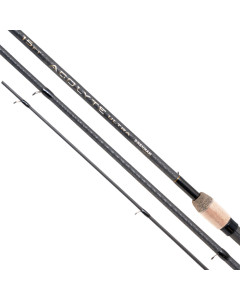This is a demo store. No orders will be fulfilled.
Grayling Fishing: Essential Techniques and Tips for Success

From the ethereal flows of clear, chilly rivers emerges an angler’s gem, the enigmatic grayling. The "lady of the stream" attracts people due to her unique appearance and thrilling capture.
Grayling fishing isn’t just about tossing a line into the water and waiting; it's a refined art. When mastered, grayling fishing is an exhilarating experience. Autumn and winter present a great time for grayling fishing.
In this guide, we will help you succeed in catching grayling by teaching you important tackle and tips.
Understanding Grayling Fish
During the winter months, grayling becomes a target for specialist and coarse anglers. This shift in focus attracts a growing number of anglers who eagerly break out trotting gear in pursuit of grayling. As dedicated anglers, we know that understanding your quarry is the first step towards success on the water.
Do grayling fight hard?
The grayling is a unique species, sought after by fly anglers for its fighting spirit and distinctive appearance. With their soft and fleshy mouths, using an overly stiff or heavy rod can result in frustrating long-distance releases. So, choose your gear wisely to make the most of your grayling fishing adventures!
How Do I Identify a Grayling?
Grayling, scientifically known as Thymallus thymallus, is a species of freshwater fish that captivates anglers with their distinctive appearance and lively behaviour.
The Allure of Grayling Fishing
So, what makes Grayling fishing such an enticing pursuit for anglers of all levels? Here are a few compelling reasons:
1. Spectacular Beauty: Grayling is, without a doubt, one of the most visually stunning fish you can encounter. Their iridescent dorsal fin alone is enough to leave any angler in awe.
2. Challenging Sport: Grayling can be elusive, with delicate feeding habits. Anglers often find themselves in a true test of skill, as stalking and tempting these fish can be both challenging and immensely rewarding.
3. Cold Weather Action: During these colder months, their activity peaks. As a bonus, rivers are more peaceful for the dedicated angler in the cooler months. However, remember to prepare and equip yourself with suitable gear, ensuring a warm and comfortable fishing experience.
4. Fly Fishing Nirvana: Grayling are renowned for their responsiveness to fly fishing techniques. Their willingness to strike at the surface and their delicate bites make fly fishing for Grayling an art form all its own.
Essential Gear and Equipment
A significant aspect to navigate is tackle choice. Consider the size and species of grayling in your chosen location. Light tackle often proves more effective, ensuring sensitivity and subtlety in your presentation. Remember, the grayling is a discerning fish and a delicate approach often reaps the most rewarding results.
Rods and Reels
We recommend choosing a classic match-style rod with a delicate playing action. Ideally, a 14ft light rod or a 13ft rod for beginners.
A light to medium action rod paired with a smooth centrepin reel can enhance your grayling fishing experience, ensuring sensitivity to the fish’s subtle bites and providing adequate fighting power.
Lines and Terminal Tackle
Your fishing line and leader choice should facilitate stealth and precision. For lines, use a 4lb breaking strain, as grayling, despite their size, put up a strong fight.
Be sure to use the right hooks for grayling due to their bony mouths. The ideal hooklength measures between 4 to 6 inches. Attach a maggot hook sized 12 to 14, consider using larger size 10 hooks for specimens. Opt for barbless hooks that offer sharpness and penetration, enhancing presentation.
What float for grayling fishing?
Choosing the right float is essential in grayling fishing, as these fish prefer shallow, fast-flowing waters with changing conditions. Selects a dome-topped stick float with a wire stem. These provide both sensitivity and stability to navigate turbulent river sections. This design allows him to detect bites and handle rough patches of the river.
What is the best bait for grayling?
Using maggots and sweetcorn as your primary bait, you can explore the river's clear, fast runs and employ a feeding strategy to attract a shoal of grayling with the trotting method.
Red maggots are a prime choice for grayling bait, especially when trotting with a stick float. They attract a variety of species, providing anglers with continuous action during their fishing experience.
A grayling weighing over a pound is considered a genuine wild river specimen. To target such specimens, use larger baits like sweetcorn. Grayling have small mouths, making it difficult for them to consume larger baits.
Tailoring your bait and lures to mimic the grayling's natural prey is key. Whether you opt for natural baits or artificial lures, ensure they resonate with the grayling’s current feeding preferences to increase your success rate.
Where can I fish for grayling UK?
You can find healthy grayling populations in renowned rivers like the Test, Eden, Avon, and the Itchen. Utilise online resources and seek advice from fellow anglers to discover grayling fishing near me.
Where do you find grayling on a river?
Selecting the correct fishing venue is crucial. Grayling thrives in rivers, particularly in the upper reaches where other game fish are abundant. They prefer clear, fast-flowing, and pristine waters, such as chalk streams.
What months are best for grayling fishing?
While grayling can be targeted throughout the year, the pinnacle of grayling fishing typically occurs between September and December.
During these months, grayling display remarkable activity levels, gathering in schools as they prepare for the winter ahead. These months witness grayling in their prime, feeding actively throughout the day.
Many seasoned fly fishermen hold a consensus that the cold, yet dry, winter days provide the perfect conditions for a successful grayling fishing expedition. Moreover, this period offers a picturesque riverside experience, as the valleys come alive with the vivid hues of autumn.
What is the best method for grayling fishing?
Traditional methods, such as trotting and fly fishing have stood the test of time, providing a continuously effective and enjoyable way to fish for grayling.
Trotting for Grayling
- Utilising a centre-pin reel and a stick float
- Trotting allows your bait to traverse naturally with the current
- It’s all about finesse and precision
- Allowing the bait to dance enticingly
- Capturing the attention of the wary grayling
- Especially magical during cool, crisp autumn mornings
- Use with 2.5lb line
- Opt for a "shirt button" style shotting pattern
- Use a barbless hook to minimize mouth damage
- Consider using a centrepin reel for a more traditional feel
Fly Fishing for Grayling
- Use it on those slightly warmer days
- Ideal where insect life begins to buzz
- Try small dry flies; Hare's ears, Klinkhammer or Sedges
- Use Czech nymphs in winter
- Remember to wade safely
Feeder fishing with liquidized bread and sweetcorn can also be highly effective for grayling, as well as for other river specimens like chub or barbel.
What Fly is Best for Grayling Fishing?
Fly fishing with nymphs or dry flies is a top method for capturing grayling, mimicking their natural prey effectively. Pay keen attention to the choice of flies, ensuring they mimic the natural insects in the environment. From nymphs to dry flies, the variety is your playground, offering an assortment of options to captivate the curious grayling.
Perfecting Your Technique
Casting Techniques: Effective casting is an art. Mastering the ability to cast with accuracy and delicacy will position your bait naturally, enticing the grayling to strike.
Reading the Water: Watercraft and understanding river features are quintessential. Areas with a faster current, known as glides, are particularly favourable, as grayling tend to congregate here.
Feeding Pattern: Consistently introduce maggots into the water to keep the bait moving to stimulate the fish's interest. Grayling are attracted to the 'bubble line,' where natural food accumulates, making it an ideal spot to target.
Common Mistakes to Avoid
Fishing for grayling is not without its challenges. Gain insights into common difficulties and effective strategies to overcome them, ensuring a rewarding fishing adventure.
1. Insufficient Research
- Mistake: Not knowing grayling behaviour or preferred bait.
- Avoidance: Research grayling habits, habitat, and seasons.
2. Ignoring Seasons
- Mistake: Not considering seasonal variations.
- Avoidance: Plan trips according to active grayling seasons.
3. Overcasting
- Mistake: Casting too far or forcefully.
- Avoidance: Practice accurate, subtle casting.
4. Poor Bait Presentation
- Mistake: Not presenting bait naturally.
- Avoidance: Focus on natural presentation.
5. Neglecting Stealth
- Mistake: Being careless or noisy.
- Avoidance: Approach quietly, avoid splashing.
6. Lack of Patience
- Mistake: Impatience can lead to missed opportunities.
- Avoidance: Practice patience; wait for the right moment.
Catch and Release Ethics
Success isn’t solely measured by the catch; ethical considerations and sustainability are paramount. Practise catch and release, handling the grayling with care and respect to preserve their population and health.
Catch and Release Gear: Equip yourself with a suitable net, unhooking mat and a pair of forceps, even a disgorger.
Handle with Care: When handling grayling, wet your hands to avoid removing their protective slime layer, which can make them vulnerable to infections. Use a soft, gentle touch to minimize stress.
Proper Holding: Hold the grayling horizontally, supporting their body, and never squeeze too tightly. Avoid dropping them or allowing them to flop onto hard surfaces.
Quick Photos: If you wish to take photos, keep the fish close to the water's surface and ensure a quick, stress-free photoshoot before releasing them promptly.
Minimise Air Exposure: Limit the time the grayling is out of the water to prevent excessive stress. A few seconds is all it takes for a successful release.
Revive in Flow: When releasing grayling, gently move them back and forth in the water to help them regain strength. Ensure they swim away under their power in an upright position.
Stay Informed: Familiarise yourself with local regulations and catch-and-release guidelines, and follow tips from the Grayling Society.
It is vital to handle grayling with care, as they expend much energy during the fight and need time to recover before release.
Safety Precautions for Grayling Fishing
When fishing for grayling, safety is paramount. Here are key considerations:


- Weather: Dress in layers and monitor weather forecasts. Be prepared for sudden changes.
- River Currents: Understand water currents and use proper gear like waders and boots.
- Wildlife: Respect wildlife, keep a safe distance and store food securely to avoid encounters.
- Emergency Kit: Pack a first aid kit, extra food and water and a map.
In conclusion, grayling fishing is a captivating pursuit, rich in tradition, technique, and the promise of exhilarating encounters. Arm yourself with knowledge, refine your strategies, and embrace the rhythms of nature, and you'll find yourself not just catching grayling, but also capturing moments of triumph and wonder in the breathtaking theatre of our British rivers.
Embarking on a grayling fishing adventure is a remarkable journey. Armed with essential techniques and insights, you are now better prepared to navigate the waters, facing the challenges and embracing the triumphs that grayling fishing has to offer.
FAQs on Grayling Fishing
What months are best for grayling fishing in the UK?
In the UK, the prime months for grayling fishing are from September to December. During this period, graylings are actively feeding and forming shoals, preparing for the winter season.
Where is the best place to catch grayling?
Notable places to catch grayling in the UK include the Lower Itchen Fishery, Romsey, Hampshire, and the River Don, Sheffield, South Yorkshire. These locations offer abundant opportunities for a rewarding grayling fishing experience as stated in the Angling Times.
What is the best tackle for grayling?
River fishing for grayling often involves covering a lot of water as grayling can be found in pockets along the river. However, they can be easily spooked, leading to sudden stops in activity. Therefore, travelling light with minimal tackle, including the rod, reel, landing net, hooks, shot, disgorger, spare floats, and maggots, is recommended.
Is there a closed season for grayling?
Grayling fishing comes with a responsibility to adhere to the close season, which currently spans from the 15th of March to the 15th of June. This period is carefully designated to safeguard grayling during their vital spawning and breeding season.























